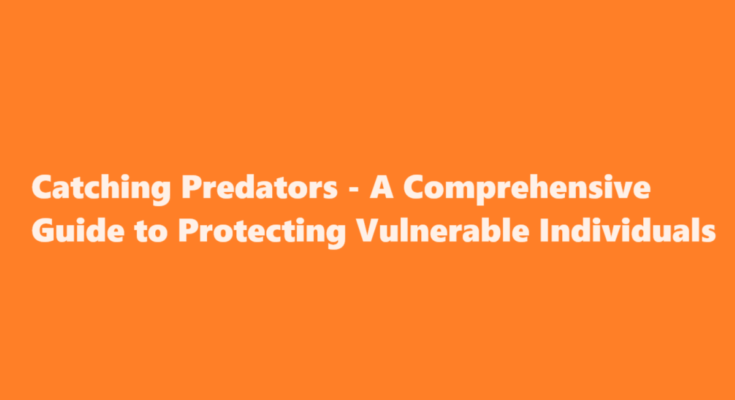Introduction
The safety and well-being of vulnerable individuals, particularly children and teenagers, is of paramount importance in today’s digital age. With the advent of the internet and social media, the potential for online predators to exploit and harm those who are not well-informed or adequately protected has increased. This article aims to provide a comprehensive guide on how to catch online predators to safeguard the most vulnerable members of our society.
Understanding Online Predators
Online predators are individuals who exploit the anonymity and reach of the internet to target and manipulate potential victims, typically for sexual exploitation or other nefarious purposes. These individuals often employ various tactics to groom and establish trust with their victims. Understanding their behavior and methods is crucial to effectively identify and catch them.
Educate Yourself
The first step in catching online predators is to educate yourself about their tactics and behaviors. Understanding their methods, such as grooming, manipulation, and deception, can help you recognize warning signs. Familiarize yourself with common platforms and apps where predators might operate and be aware of the signs of potential danger.
Communicate Openly
Encourage open communication with your children, friends, and family members about online activities. Creating a non-judgmental space for individuals to share their online experiences will make it easier for them to discuss any concerns or unusual interactions they encounter. Trust is essential in preventing and identifying potential predator encounters.
Monitor Online Activities
Parents should actively monitor their children’s online activities. This includes keeping an eye on the websites they visit, the apps they use, and their social media profiles. Many parental control apps are available to help track and restrict online interactions.
Watch for Warning Signs
Be vigilant for signs that someone may be interacting with an online predator. These signs can include sudden secrecy about online activities, unexplained gifts or money, and behavioral changes. It’s important to take these signs seriously and investigate further.
Identifying Online Predators
To catch an online predator, it’s essential to identify them and gather evidence that can be used to bring them to justice. Here are the steps to take when you suspect someone is an online predator.
Document All Interactions
If you suspect someone is an online predator, document all interactions, including messages, emails, and any other forms of communication. This documentation will serve as critical evidence later if needed.
Take Screenshots
Take screenshots of conversations, profiles, or any suspicious content that you come across. Screenshots provide a timestamped record of interactions, which can be crucial in legal proceedings.
Report to Authorities
Contact your local law enforcement agency and provide them with all the evidence you’ve gathered. They have the expertise and resources to investigate online predators and take appropriate action.
Report to Online Platforms
Report the predator to the platform or website where the interactions occurred. Most platforms have mechanisms for reporting suspicious activity or users. Providing this information can help prevent the predator from victimizing others.
Seek Legal Advice
Consult with an attorney who specializes in cybercrime or internet law. They can guide you through the legal process and help you understand your rights and responsibilities.
Preventing Online Predation
Prevention is always the best approach to protecting vulnerable individuals from online predators. Here are some strategies to minimize the risk of falling victim to predators.
Privacy Settings
Teach children and teenagers about privacy settings on social media platforms. Encourage them to keep their profiles private and only accept friend requests from people they know in real life.
Online Etiquette
Educate young people about appropriate online behavior, the dangers of sharing personal information, and the importance of not engaging with strangers.
Online Friendships
Emphasize the difference between online friends and real-life friends. Encourage your children to be cautious when forming relationships with individuals they have not met in person.
Password Security
Teach your children about the importance of strong, unique passwords for their online accounts. Emphasize the need to change passwords regularly and avoid sharing them with anyone.
Reporting Suspicious Activity
Instruct your children on how to report suspicious interactions to you and to the platform or website administrators. Encourage open communication about any concerns they may have.
FREQUENTLY ASKED QUESTIONS
Why did Catch a Predator get Canceled?
The show was rife with controversy, and ultimately ended due to a major controversy involving one of the alleged pedophiles committing suicide when police arrived. To Catch A Predator was finished, but Chris Hansen was not.
Is How to Catch a Predator fake?
To Catch A Predator lacked journalistic integrity, focusing more on ratings than reporting crimes, causing controversy among journalists and critics. The show’s efforts to catch predators didn’t always result in justice, with instances of offenders not being charged or acquitted due to entrapment and tainted evidence.
Conclusion
Online predators pose a significant threat to vulnerable individuals in our digital age. It is crucial for parents, guardians, and concerned individuals to educate themselves about the methods and behaviors of online predators. By taking steps to prevent predation and knowing how to identify and report potential predators, we can work together to protect those at risk and ensure their safety in the online world. Staying vigilant and informed is the key to catching online predators and preventing harm to the most vulnerable members of our society.
Read Also : Mastering The Art of Reheating Salmon – A Culinary Guide



